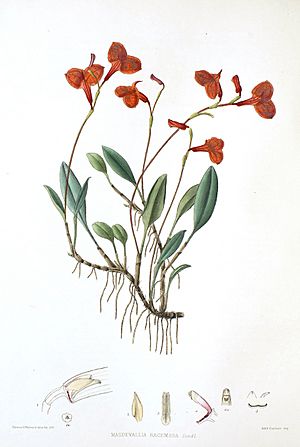Florence Woolward facts for kids
Florence Helen Woolward (born in Hammersmith in 1854, died in 1936) was a talented English artist and writer. She was famous for her beautiful drawings of plants, especially orchids. A rich collector, Schomberg Kerr, 9th Marquess of Lothian, hired her to paint his huge collection of orchids. Her amazing work was published in a book called "The Genus Masdevallia" between 1891 and 1896.
Contents
Who Was Florence Woolward?
Florence Woolward was a freelance artist. This means she worked for herself and took on different projects. She was the daughter of a reverend. Florence lived in a place called Belton in Lincolnshire.
Even though she didn't go to art school or study plants formally, she became very good at both. She was hired by the Marquess of Lothian to draw his orchids and fungi. These plants came from his homes, Newbattle Abbey and Monteviot House. After finishing this big project, she even worked at the Natural History Museum.
Her Amazing Orchid Book
"The Genus Masdevallia" is thought to be one of the best orchid books from the Victorian times. The Marquess loved orchids very much. He was especially fond of a type called Masdevallias, which came from the Andes mountains. He had a very large collection of them at his home, Newbattle Abbey in Scotland.
Many of these special orchids came from a plant collector named Friedrich Carl Lehmann. Florence spent about ten years visiting Newbattle Abbey. During this time, she drew more than 350 different orchids. About 85 of these were the Masdevallia type.
Drawing and Publishing the Book
At first, Florence had trouble finding a plant expert to write the descriptions for her drawings. So, she decided to write them herself! She likely got help from experts at the British Museum during her visits.
The book came out in nine parts between 1891 and 1896. Each part had ten drawings and their descriptions. The last part had seven drawings. The whole set cost £13 10s, which was a lot of money back then.
Each plant drawing had detailed notes about where it grew in the Andes. These notes were written by Friedrich Carl Lehmann. Florence herself made the lithographs for the drawings. Lithography is a printing method. She also hand-colored each picture. This meant she colored almost 9,000 plates herself to make sure they were perfect!
Florence wrote in the book's introduction: "It is no doubt advantageous in botanical work … that the person who makes the original drawing from nature should also lithograph the plates and indicate the colours to be used by the colorist, for, by this means, the work passes through fewer hands and is more likely to turn out accurate." This shows how much care she put into her work.
Later Discoveries
After the book was published, some of Florence's original drawings were kept by her family. For a long time, no one knew where they were. But they were finally found with two of her great-nieces living near the Welsh Marches.
An old trunk held not only the drawings but also old photos, hand-painted china, and other special items. These important drawings were given to the Royal Botanic Gardens, Kew. They joined other original sketches by Florence that had been given to Kew in 1937.
Florence Woolward's later works for the Natural History Museum are also very impressive. They show her amazing drawing skills and how accurate she was with plant details. She stopped working on elms and poplars around 1908. After that, she seemed to stop creating new works.



